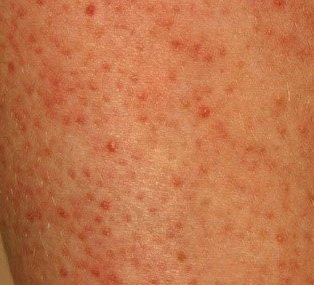

TINY PINPOINT RED DOTS ON SKIN PICTURES FREE
Wash clothes in a detergent free of irritants such as perfumes and dyes.ĭon't scratch. Choose clothing made of soft, breathable fabrics like cotton when possible. After a bath or swimming, gently pat your child's skin with a towel and then apply moisturizer to his or her damp skin.ĭress wisely. Apply fragrance-free creams or ointments at least once a day or more often if needed. Overheating, sweating and chlorine in swimming pools also can trigger eczema. But dryness caused by air conditioning and pressurized planes during summer travel can cause problems, too. While mild cases can be treated at home, talk with your pediatrician if your child is especially uncomfortable, the rash is severe and/or isn't going away, if the rash is on your child's face or groin area, or if you notice signs of infection (i.e., fever, redness, swelling beyond the poison ivy or oak lesions).Įczema (also called atopic dermatitis or AD) is a chronic condition common in children that causes patches of dry, scaly red skin and tends to flare up during colder months when there's less moisture in the air. Another good option to reduce skin inflammation is 1% hydrocortisone cream. Avoid ointments containing anesthetics or antihistamines-they can cause allergic reactions themselves. If the rash is mild, apply calamine lotion to cut down on the itching. This will also prevent the rash from spreading if there is still a small amount of oil under the fingernails. To discourage scratching and further damage to the skin, keep your child's fingernails trimmed. Also, wash the area of the skin that was exposed with soap and water for at least 10 minutes after the plant or the oil is touched. If your child comes into contact with these plants, wash all of his or her clothes and shoes in soap and water. If you have younger children, inspect the parks they play in and have rash-causing plants removed. Both poison ivy and poison oak have shiny green leaves that grow three to a stem, so you might share the rhyme: "Leaves of three, let them be." The sumac shrub has stems that contain 7-13 leaves arranged in pairs, while wild parsnip and giant hogweed have clusters of small, flat-topped yellow and white flowers.
TINY PINPOINT RED DOTS ON SKIN PICTURES HOW TO
Teach your child what these plants look like and how to avoid them. Other plants-such as wild parsnip, giant hogweed, and citrus-contain chemicals that make skin hypersensitive to sunlight and cause a phytophotodermatitis rash.

An allergic skin reaction causes redness, swelling and blisters. Many children get a burning, intensely itchy rash where their skin touches plants-such as poison ivy, poison oak, sumac-containing a sticky oil called urushiol. Leave areas open to air without clothing. Wash areas of the skin that stay wet with sweat, urine, or drool with cool water. If possible, use fans and air conditioning to avoid overheating. Dress your child in clothing that keeps the skin cool and dry. The rash looks like patches of small pink or red bumps or blisters under clothing or spots where skin tends to fold-on the neck, elbows, armpits, or thighs-although heat rash can occur on other covered areas. Heat rash ( also known as prickly heat or miliaria) is seen most often in babies and young children when sweat gland pores become blocked and perspiration can't escape.

Balmy weather also can lead to itchy, irritated skin.Ĭheck out the list from the American Academy of Pediatrics (AAP) to see how you can help prevent, identify, and soothe these common summertime skin rashes. Sunny days and starlit evenings spent playing, splashing, and exploring can leave kids with more than warm summertime memories.


 0 kommentar(er)
0 kommentar(er)
